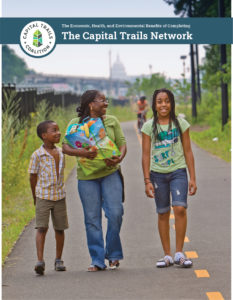This criteria sets the framework for which trails—existing and planned—are included in the network.
This criteria was finalized Aug. 2016 and refined Aug. 2017.
The creation of the criteria was spearheaded by the Analytics working group, and approved by the full Coalition.
Exceptions to criteria: There are trails within the Coalition’s footprint that do not meet the criteria but are considered to be essential spines of their respective jurisdiction’s multi-use trail network. These trails have been adopted into the identified network as of September 2017.
| Off-road/On-road |
- Off-street, separated from moving traffic.
- Provision for on-street facilities for connection.
- On-street facility trail connectors may not be accessible to all ages and abilities and will be marked as “needs improved” for continuous trail connection.
|
| Width |
- 10-12 feet minimum.
- Designed for probable use.
- Wider if demand warrants.
- Narrower in short segments to accommodate design constraints.
- 8 feet minimum acceptable for existing trails (2017), but 10 feet minimum required for new trails.
|
| Design Standards |
- New trails (from Planned to Existing, post-2017) designed according to best practices (E.g. AASHTO standards).
|
| Types of Use |
- Designed for non-motorized use.
|
| Paved/Unpaved |
- Paved.
- Firm, crushed stone where appropriate.
- Boardwalks and bridges are acceptable.
|
| Relation to the Network |
- Is directly connected to the overall system or will be part of the system with the completion of future planned trails.
- This connection also needs to be in the form of a physical multi-use trail
- “Thematic” connections are not acceptable
- Each trail should connect to the overall network at at-least one point.
- Even if individual trail segments are short, the completed trail should connect places
|
| Transportation/Recreation |
- Well-suited for serving both transportation and recreation purposes.
- Connecting people to transit, activity centers, and recreation areas
|
| Feasibility |
- Right of way identified and trail capable of being built within 25 years.
- Planned trails must have associated, locally approved plan
|

